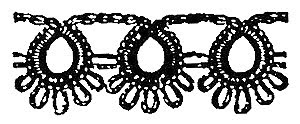I’ve decided that I didn’t have enough to do so I’ve been learning to tat. Tatting is an ancient art and one that many fear will disappear. So I thought as a person who loves history, it was up to me to help save this wonderful artform.
Tatting has a varied history. Many people think it relates back to fishing nets. In the Victorian age it was considered unlady-like to sit idle. Ladies often occupied themselves with tatting or some other form of needlework. Tatting was easy to carry with them to visits and resulted in beautiful pieces of lace.
There are all sorts of styles and every country seems to call it by a different name. The German word for tatting is Schiffchenarbeit meaning ‘the work of the little boat’. Since the shuttles used in tatting are boat shaped this makes sense to me. The Italians call it occhi meaning ‘eyes’,
referring to the rings which make up the lace; the Turkish say
makouk which is their word for shuttle; the French call it frivolite
and the Swedish word is similar – frivolitet.
But no matter what you call it – tatting is a wonderful craft to learn. I have an incredible teacher I meet with from time to time. Her name is Pru and she is one super smart lady. She has a passion for keeping tatting alive and I have great admiration for her.
Tatting requires a shuttle,
thread and a lot of patience.  There are special ways to hold your hands and position your shuttle and thread, and of course there are specific patterns to follow and stitches to learn.
There are special ways to hold your hands and position your shuttle and thread, and of course there are specific patterns to follow and stitches to learn.
The result can be all sorts of projects from bookmarks to lace trim to clothing and
handbag decoration.
and today antique tatting is highly sought by collectors. Who knows maybe 100 years from now – collectors will be fighting to buy my tatting–but at this early stage of learning – I kind of doubt it.
God Bless You




